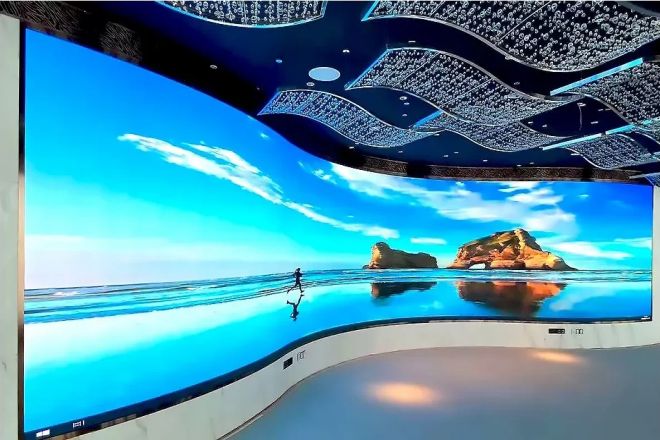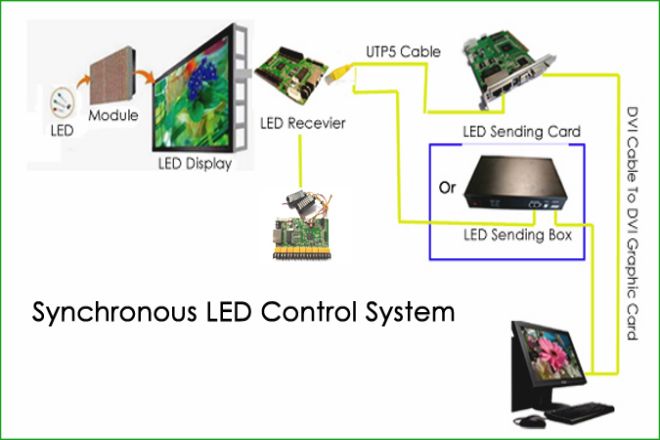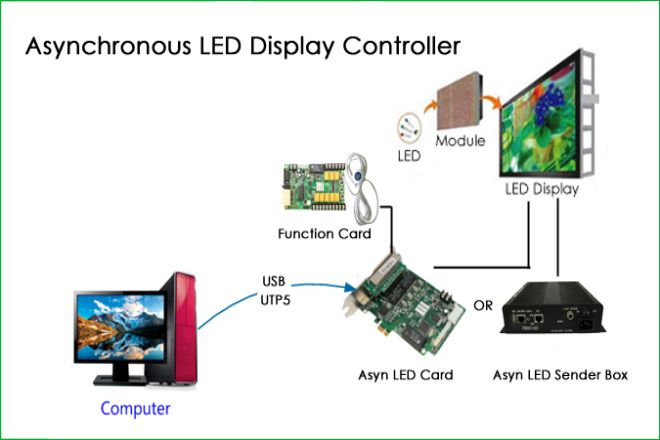Introduction

With its high brightness, high definition, and long life, the LED display has brought revolutionary changes to the dissemination of information.
In the control system of LED display, synchronous control, and asynchronous control are two common control methods. They have their own characteristics and are suitable for different application scenarios.
Synchronous control emphasizes the real-time and display consistency of data, while step-by-step control pays more attention to the stability of the system and the simplicity of operation.
So, do you choose synchronous control or asynchronous control? Read the article, and you will get the answer.
1. Advantages and disadvantages of using synchronous control for LED display
The synchronization control of the LED display refers to the use of external clock signals to synchronize the refresh of the LED display. Under synchronous control, the image data is transmitted at a fixed frame rate and timing and is synchronized with the external clock signal.

1). Advantage
- Fast information update:
Synchronization control is like a “real-time translator.” It always pays attention to the information that needs to be displayed. Once there is an update, it can be displayed on the LED display immediately. This means that whether you watch news, games, or other real-time content, you can get the latest information and not miss any important moments.
- Uniform display effect:
If you have multiple LED displays and want them to display the same content, synchronous control is your best choice. It can ensure that the content on all display screens is consistent. Whether it is color, text, or image, it can be perfectly presented, bringing shocking visual effects to the audience.
- Flexible operation:
Synchronization control is not only fast to update but also very flexible in operation. You can change the display content at any time through simple operation, just like changing slides at home. In addition, synchronous control also supports remote operation. No matter where you are, as long as there is a network, you can easily control the content of the LED display.
2). Shortcoming
- Professional maintenance is required:
Although the synchronization control function is powerful, it is not easy to set up. Professionals are usually required for initial setup and subsequent maintenance. If you don’t have a relevant technical background, you may need to spend some time and money to find the right maintenance personnel.
- High price:
Synchronous control requires some advanced hardware and software to support, and these advanced devices are usually expensive. Therefore, choosing synchronous control may increase your overall investment cost.
- The network should be stable:
synchronous control relies on a stable network connection to transmit data. If the network is unstable or fails, it may cause the LED display to not work properly and even cause problems such as stuttering and flickering. Therefore, when using synchronous control, you need to ensure that the network connection is stable and reliable.
2. Advantages and disadvantages of using asynchronous control of LED display
The asynchronous control of the LED display is a relatively independent and flexible control method. In this mode, the control card or controller will store the image data that needs to be displayed in advance and then send the data directly to the LED display for display without keeping pace with the external clock signal.

1). Advantage
- High autonomy:
Asynchronous control enables the LED display to work independently without keeping pace with other devices or systems. This means that you can change the display content according to your needs at any time without waiting for external signals or clock synchronization. This autonomy provides great flexibility for users.
- Cost saving:
Because asynchronous control does not require additional hardware equipment to generate and transmit external clock signals, the hardware requirements of the whole system are relatively low. This reduces the complexity and cost of the system, making asynchronous control an ideal choice for users with limited budgets.
- Real-time update ability:
Asynchronous control allows users to update the display content in real time. Whether it’s text, pictures, or videos, you can send new content to the display at any time without downtime or reconfiguration.
- Simplified maintenance:
Because the system structure is relatively simple, the asynchronously controlled LED display is also more convenient for maintenance. In the event of a failure or problem, it is usually easier to troubleshoot and repair.
2). Shortcoming
- Display delay:
Because asynchronous control does not depend on external clock signals, there may be a certain display delay. That is, when you send new display content, the display may take a period of time to update, so the content the user sees may not be up to date.
- Synchronization problem:
Although asynchronous control provides great flexibility, it may also cause the display content to be not completely consistent with expectations. Because there is no synchronization of external clock signals, the display may shake or flicker slightly, affecting the display effect.
- Scope of application:
Asynchronous control is usually suitable for small LED displays. For large, high-resolution displays, asynchronous control may not meet its display needs because it is limited by the storage and processing capacity of the control card or controller.
3. How do you determine which control method is suitable for your LED display?

When choosing the control method for the LED display, you can consider these factors:
- Size and clarity of the display:
Imagine that you have an oversized LED display that occupies the whole wall. In this case, the display of each pixel is very important because it directly determines whether the audience can see the content clearly. If the control is not accurate enough, it may cause pixel misalignment or color distortion, which will affect the overall display effect.
Synchronous control is like an accurate conductor, which can ensure that each pixel is fully synchronized with the image data, thus presenting a clearer and more stable picture. Therefore, synchronization control is usually a better choice for large or high-resolution displays.
- Frequency of update content:
Have you seen those LED advertising screens in the bustling neighborhood? This LED advertising screen needs to change the advertising content frequently to attract the attention of passers-by. If you have to wait for a long time every time you change the content, the effect of the advertisement will be greatly reduced.
Asynchronous control is like a flexible dancer, which can change the display content according to your needs at any time without waiting for a fixed refresh time. This means that you can change the content on the billboard at any time without worrying about delay or waiting. Therefore, asynchronous control is a more suitable choice for displays that need to be updated frequently.
- Budget issues:
Budget is also a very important consideration when choosing the LED display control method. After all, different control methods may require different hardware equipment and technical support, which will affect your overall investment.
Usually, asynchronous control is cheaper than synchronous control. This is because asynchronous control does not require additional hardware devices to synchronize, thus reducing costs. If you have a limited budget but want a powerful LED display, then asynchronous control may be a more suitable choice.
- Location and environment of the display:
The location of the display screen and the surrounding environment will also affect the choice of control method. For example, if your display screen is outdoors, it may be affected by natural factors such as wind, rain, and sunlight. In this case, you need to choose a more stable and durable control method to ensure the normal operation of the display.
In addition, if there are many interference sources around the display screen, such as electromagnetic interference or light interference, you also need to choose a control method that can resist these interferences.
- Technical support and maintenance:
Finally, we should also consider the issue of technical support and maintenance. Different control methods may require different technical support and maintenance services, which will also affect your user experience.
When choosing a control method, you should consider choosing one with good technical support and maintenance services. In this way, in the event of a problem or failure, you can quickly get help and support to ensure the normal operation of the display.
Conclusion
Is it better to use synchronous control or asynchronous control? In fact, you should choose according to the actual situation of your LED display. I believe you have got the answer.
If you want to know more about LED displays, please get in touch with us!
